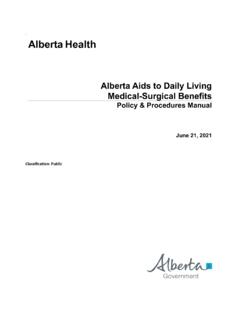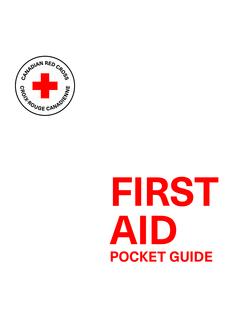Transcription of Prevention and control of infection in care homes ...
1 1 Prevention and control of infection in care homes Summary for staff DH INFORMATION READER BOX Clinical Estates Policy HR / Workforce Commissioner Development IM & T Management Provider Development Finance Planning / Performance Improvement and Efficiency Social care / Partnership Working Document Purpose Best Practice Guidance Gateway reference 17405 Title Prevention and control of infection in care homes : Summary for staff Author Department of Health and Health Protection Agency Publication Date 18 February 2013 Target Audience care Trust CEs, GPs, Communications Leads, Consultants in Communicable Disease control , Community infection control Nurses, Health Protection Nurses, care Home Managers, care Quality Commission Circulation List Local Authority CEs, Directors of Adult SSs Description An information resource to assist staff in taking all reasonable steps to protect residents and staff from acquiring infections and prevent cross infection .
2 And to provide information and guidance on infection Prevention and control that will assist managers in undertaking risk assessments and in developing policies. Cross Ref The Health and Social care Act 2008: Code of Practice on the Prevention and control of infections and related guidance Superseded Docs infection control Guidance for care homes (Department of Health, 2006) Action Required Timing Contact Details N/A N/A SW1W 9SZ Philip Pugh Healthcare Associated infection and Antimicrobial Resistance Programme Health Protection Agency Central Office, 151 Buckingham Palace Road, London For Recipient's Use Chain of infection The chain of infection provides an overview of the process by which a resident acquires any type of infection .
3 The characteristics of each link show how organisms are transferred. Breaking the link or cycle is necessary to prevent the spread of any infection . MRSA Clostridium difficile Pseudomonas aeruginosa Norovirus Influenza Virus, bacteria & fungus Break in skin (wound) cut or needlestick injury Mucous membranes (mouth, eyes,nose) Inhalation (breathing) Way into the body Contact - Hands Contact - Equipment Droplet - Influenza Airborne - TB Method of spread Standard infection Prevention & control precautions A simple, consistent and effective approach to infection Prevention & control Hand hygiene Use of gloves Safe handling of sharps Personal protective equipment Use of gowns/apron Safe handling of waste Safe handling of soiled linen Environmental cleaning Minimise contact with blood and body fluids by ensuring safe working practices.
4 Protective barriers and a safe working environment Hand washing technique with soap and water Wash hands when visibly soiled! Otherwise, use handrub. Hands should be washed before and after all care procedures, and handling food. Also after dealing with used linen, waste and body fluids or contaminated equipment and after removing gloves. tap; Adapted from World Health Organisation Clean care is Safer care About Save Lives: Clean Your Hands Asepsis and aseptic technique The principles of asepsis play a vital role in the Prevention of infection in all environments and is the responsibility of all care staff to understand these incorporating them into their everyday practice where it is relevant.
5 The principles of asepsis/aseptic technique require that: Exposure of any susceptable areas is kept to a minimum. Exposure Correct hand decontamination should be carried out. Hand hygiene Correct type of gloves are used as appropriate. Gloves Uniform and clothing is protected with a disposable plastic apron. Clothing All fluids and materials used are sterile. Materials Sterile packs are checked for damage, expiry or moisture penetration. Sterile Contaminated non-sterile items are not placed in the sterile area. Non-sterile Single use items are never reused. Single use My 5 Moments for Hand Hygiene The M y 5 moments for Hand Hygiene approach defines the key moments when health care workers should carry out hand hygiene.
6 This evidence based, field tested, user-centred approach is designed to be easy to learn, logical and applicable in a wide range of settings. This approach recommends health- care workers to clean their hands: 1. before touching a resident, 2. before clean/aseptic procedures, 3. after body fluid exposure/risk, 4. 5. after touching a resident, and after touching a persons surroundings. 1 BEFORE TOUCHING A RESIDENT 4 AFTER TOUCHING A RESIDENT Adapted from World Health Organisation Clean care is Safer care About Save Lives: Clean Your Hands Alcohol hand-rub hand hygiene technique for visibly clean hands Rub hands for hand hygiene! Wash hands when visibly soiled.
7 Alcohol hand rubs are an effective and rapid means of hand decontamination and should only be used on visibly clean hands. Adapted from World Health Organisation Clean care is Safer care About Save Lives: Clean Your Hands Outbreaks of communicable infection or an infection control incident A number of infectious diseases may spread readily to other residents and cause outbreaks within any care setting. The commonest outbreaks are due to viral respiratory infections and gastroenteritis. The organisms may be spread by hand contact and on occasion by other routes which may include food.
8 An outbreak is defined as two or more related cases of infectious disease. Definition of an outbreak Manager/owner Health Protection Unit infection control lead All staff Residents/relatives General practitioner When and who to inform Ensure relevant persons have been informed. seek advice as appropriate re collection of microbiological specimens. Outbreak plan and response It is important to start a record keeping file and collect all data for future reference . Record keeping By using standard precautions the risk of spreading infectious disease is reduced. General control measures Consider stopping admissions, day care and transfers to other homes until considered safe to do so.
9 Admissions, discharges. My 5 Moments for Hand Hygiene The My 5 Moments for Hand Hygiene approach defines the key moments when health care workers should carry out hand hygiene. This evidence based, field tested, user-centred approach is designed to be easy to learn, logical and applicable in a wide range of settings. This approach recommends health- care workers to clean their hands: 1. before touching a resident, 2. before clean/aseptic procedures, 3. after body fluid exposure/risk, 4. after touching a resident, and 5. after touching a persons surroundings. AFTER TOUCHING A RESIDENT 4 AFTER TOUCHING A RESIDENT 1 AFTER TOUCHING RESIDENTS SURROUNDINGS 5 Adapted from World Health Organisation Clean care is Safer care About Save Lives: Clean Your Hands My 5 Moments for Hand Hygiene The My 5 Moments for Hand Hygiene approach defines the key moments when health care workers should carry out hand hygiene.
10 This evidence based, field tested, user-centred approach is designed to be easy to learn, logical and applicable in a wide range of settings. This approach recommends health- care workers to clean their hands: 1. before touching a resident, 2. before clean/aseptic procedures, 3. after body fluid exposure/risk, 4. after touching a resident, and 5. after touching a persons surroundings. AFTER TOUCHING A RESIDENT 4 AFTER TOUCHING A RESIDENT 1 AFTER TOUCHING RESIDENTS SURROUNDINGS 5 Adapted from World Health Organisation Clean care is Safer care About Save Lives: Clean Your Hands Isolation for residents with a communicable infection Isolation of infected residents may be necessary to prevent further cases of infection .

















